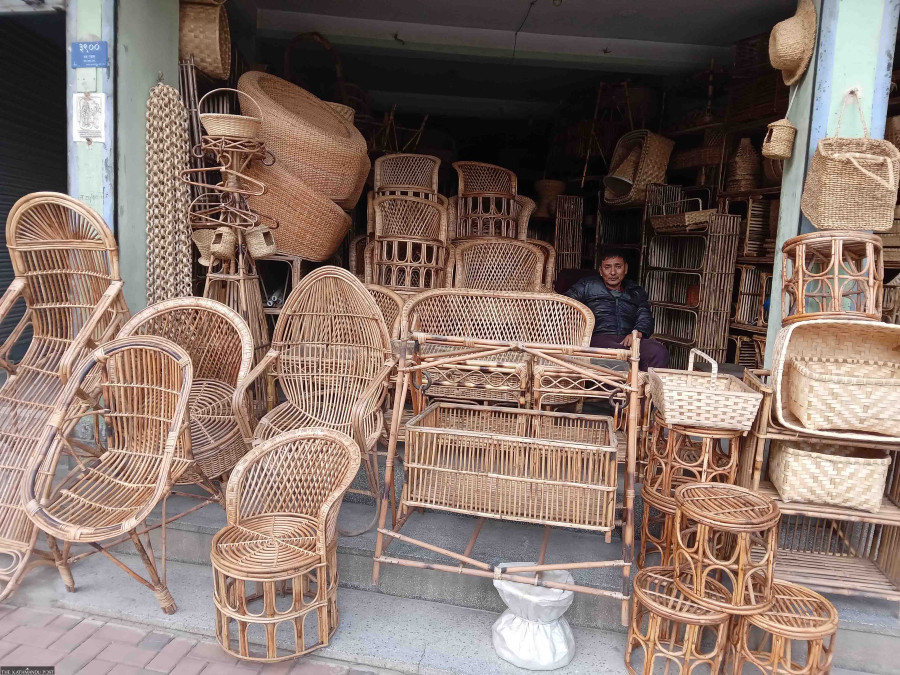Money
Rattan furniture industry seeks friendlier policy
Due to the complex paperwork required to harvest rattan, manufacturers prefer to import their raw materials from India.
Subin Adhikari
Narendra Das Shrestha, a local of Kupandol, Lalitpur, has been selling rattan furniture for 30 years. His inventory consists of chairs, tables, sofas and other furniture made from rattan vines, also known as beet, a climber plant.
His family carried on a flourishing rattan furniture business for ages, but lately it is running into difficulties due to the Covid pandemic and subsequent liquidity crisis.
“Both Nepalis and foreigners like our products, but nobody has the money now,” said Shrestha. “Every day, many people come to see the products, but they leave promptly when we tell them the price.”
Prices at Shrestha’s shop range from Rs300 for a basket to Rs70,000 for a sofa. He sources these products from factories in Godavari and Sankhu in Kathmandu Valley and as far away as Dharan.
“Foreigners buy small items to take home as souvenirs,” added Shrestha.
Adjacent to Shrestha’s shop is another rattan store run by Sumitra Nagarkoti. She mainly sells light products like baskets, table lamps and clothes hangers. The products at her shop cost from Rs200 to Rs8,000.
Nagarkoti says people have been showing greater interest in rattan products lately. “Along with individual customers, there are restaurants and cafes that buy decorative pieces.”
The products are made in her father’s factory where he has a team of six workers.
Interest in rattan products is increasing as they are handmade using natural materials without harmful colours or chemicals.
If protected from direct sunlight and rain, rattan furniture can last for more than 30 years, traders say.
Rattan traders are concerned by growing competition from cheaper imported furniture. They say the government should adopt a protectionist policy to save domestic industry from collapsing.
Making rattan furniture is a skill-based business that has been passed down from generation to generation in local communities. They are often run by families and are not registered, and so have limited access to bank loans, government subsidies and other benefits.
To add to their woes, sourcing raw materials is becoming more difficult.
Rattan, which falls under the category of non-timber forest products, is found in the forests of Kailali, Bardiya, Dang and Chitwan districts in the Tarai.
But due to the complex paperwork required to harvest rattan, manufacturers prefer to import their raw materials from India, which fulfils around 60 percent of the domestic requirement.
In 2007, the government made it mandatory to conduct an initial environmental examination (IEE) and environmental impact assessment (EIA) to harvest more than 5 tonnes of rattan at a time from community and national forests.
The regulation requires community forest user groups to get approval from their respective Division Forest Office too. Hence, harvesting of rattan from community forests has dropped considerably.
In 2019, the government amended the Environment Protection Act and raised the threshold to 150 tonnes.
Chote Lal Chaudhary, a researcher who has written multiple research papers on rattan, says government policy discouraged community forest consumer groups from harvesting rattan due to the red tape at the Division Forest Office.
“During the period from 2007 to 2019, many manufacturers turned to Indian suppliers in the absence of regular supply from Nepali community forests,” said Chaudhary.
Besides, manufacturers say Nepali rattan is of lower quality compared to the Indian product.
“The rattan in Nepal (paani beet) is thinner than the rattan found in Siliguri in northeast India,” said Ramlal Nagarkoti who owns a rattan furniture factory in Godavari. “So we prefer to buy Indian rattan even if it’s expensive.”
Local bodies in Bardiya, Dang and Sarlahi, in association with several non-governmental organisations, have attempted to promote commercial farming of higher quality rattan. But it takes six years for a rattan plant to reach maturity and become ready for harvest.
The rattan plant is covered with thorns which makes harvesting a difficult task. Therefore, Indian workers are brought to harvest and process the rattan in most Nepali community forests.
Community forest user groups and local bodies are trying to train locals to harvest and process the rattan plant, but they lack the necessary equipment.
Satti Karnali Community Forest in Kailali is the largest producer of rattan in Nepal with an annual production of around 480 tonnes. Until a few years ago, they depended on Indian workers, but now they have a team of 40 locals to harvest and process rattan.
Processing work finishes by the first week of May and the product is ready for market. The community forest charges Rs45 per kg from local buyers and Rs100 per kg from traders.
Officials are concerned they may get a lower price this year due to the poor quality of rattan.
“The rattan plants have turned black due to rain during the harvesting period,” said Min Bahadur Thakulla, secretary of Satti Karnali Community Forest.
Nepal has a capacity to produce 4,400 tonnes of rattan annually while consumption is around 1,300 tonnes. But due to lack of coordination between the concerned parties, Nepali manufacturers are importing rattan from India while tonnes of rattan plants lie rotting in Nepali forests, said Chaudhary.




 15.12°C Kathmandu
15.12°C Kathmandu














